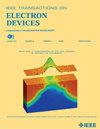Oxygen Vacancy-Induced Synaptic Plasticity in InAlZnO Nanofiber Transistors for Low-Power Neuromorphic Electronics
IF 2.9
2区 工程技术
Q2 ENGINEERING, ELECTRICAL & ELECTRONIC
引用次数: 0
Abstract
As an alternative for the future computer, the brain-like neuromorphic computing systems have been widely concerned for the characteristics of power efficiency, self-learning, and parallel computing. Meanwhile, the simulation of the synaptic behavior based on electronic devices has attracted widespread attention in past decades. In this report, indium-aluminum–zinc-oxide (InAlZnO) nanofibers were prepared by electrospinning, and the synaptic transistors based on InAlZnO nanofibers were integrated and investigated. With the excitatory response modes, the basic biological functions, including excitatory postsynaptic current (EPSC), paired-pulse facilitation (PPF), high-pass filtering properties, short-term memory (STM), and long-term memory (LTM), were simulated by the synaptic transistor. It is found that low-power consumption (~75 fJ/spike) and nonvolatility of the channel conductance for the synaptic transistor based on the InAlZnO nanofibers have been achieved. The pattern recognition training based on the long-term potentiation (LTP)/depression characteristics was developed by CrossSim simulation platform, and a recognition accuracy of 95.6% was achieved by using the Modified National Institute of Standards and Technology database. This work demonstrates a new approach for the establishment of the large-scale, energy-efficient artificial synapses for neuromorphic computing.用于低功耗神经形态电子器件的 InAlZnO 纳米纤维晶体管中氧空位诱导的突触可塑性
作为未来计算机的替代方案,类脑神经形态计算系统因其节能、自学习和并行计算等特点而受到广泛关注。与此同时,基于电子器件的突触行为模拟在过去几十年中也引起了广泛关注。本报告利用电纺丝技术制备了铟铝锌氧化物(InAlZnO)纳米纤维,并集成和研究了基于InAlZnO纳米纤维的突触晶体管。通过兴奋响应模式,突触晶体管模拟了基本的生物功能,包括兴奋性突触后电流(EPSC)、成对脉冲促进(PPF)、高通滤波器特性、短时记忆(STM)和长时记忆(LTM)。研究发现,基于 InAlZnO 纳米纤维的突触晶体管实现了低功耗(约 75 fJ/秒杀)和通道电导的非波动性。利用 CrossSim 仿真平台开发了基于长期电位(LTP)/抑制特征的模式识别训练,并利用修改后的美国国家标准与技术研究院数据库实现了 95.6% 的识别准确率。这项工作为神经形态计算建立大规模、高能效的人工突触展示了一种新方法。
本文章由计算机程序翻译,如有差异,请以英文原文为准。
求助全文
约1分钟内获得全文
求助全文
来源期刊

IEEE Transactions on Electron Devices
工程技术-工程:电子与电气
CiteScore
5.80
自引率
16.10%
发文量
937
审稿时长
3.8 months
期刊介绍:
IEEE Transactions on Electron Devices publishes original and significant contributions relating to the theory, modeling, design, performance and reliability of electron and ion integrated circuit devices and interconnects, involving insulators, metals, organic materials, micro-plasmas, semiconductors, quantum-effect structures, vacuum devices, and emerging materials with applications in bioelectronics, biomedical electronics, computation, communications, displays, microelectromechanics, imaging, micro-actuators, nanoelectronics, optoelectronics, photovoltaics, power ICs and micro-sensors. Tutorial and review papers on these subjects are also published and occasional special issues appear to present a collection of papers which treat particular areas in more depth and breadth.
文献相关原料
公司名称
产品信息
阿拉丁
polyvinylpyrrolidone
阿拉丁
zinc nitrate
阿拉丁
aluminum nitrate
阿拉丁
indium nitrate
 求助内容:
求助内容: 应助结果提醒方式:
应助结果提醒方式:


